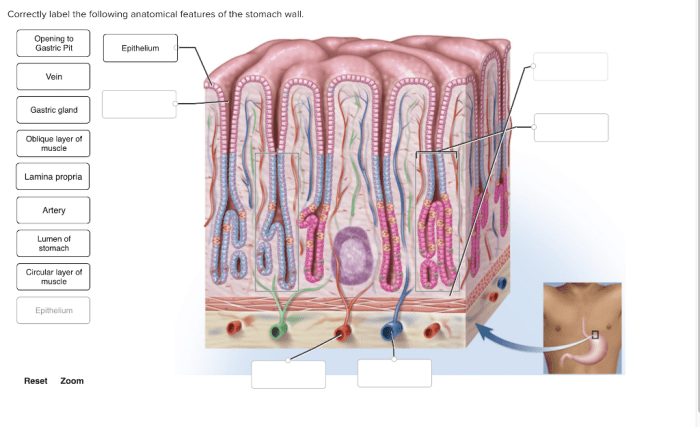Correctly label the following anatomical features of the stomach wall – Correctly labeling the anatomical features of the stomach wall is crucial for understanding its structure and function. This guide provides a comprehensive overview of the four main layers of the stomach wall, from the innermost mucosa to the outermost serosa, exploring their composition, roles, and interactions.
Delving into each layer, we will examine the gastric mucosa’s role in digestion, the submucosa’s support and nourishment, the muscularis propria’s essential contractions, and the serosa’s protective function. By understanding these intricate layers, we gain a deeper appreciation for the stomach’s remarkable ability to process food and contribute to overall digestive health.
Anatomical Layers of the Stomach Wall

The stomach wall comprises four distinct layers, each with a specific structure and function, working together to facilitate digestion.
Mucosa
- The innermost layer, the mucosa, consists of a thick layer of epithelial cells, gastric pits, and glands.
- Gastric pits are depressions in the mucosa that secrete mucus to protect the stomach lining.
- Gastric glands secrete digestive enzymes (pepsin and hydrochloric acid) into the stomach lumen.
- Mucosal folds (rugae) increase the surface area for absorption and secretion.
Submucosa
- A layer of connective tissue containing blood vessels, nerves, and lymphatic vessels.
- Submucosal blood vessels supply nutrients and oxygen to the stomach wall.
- Nerves regulate muscle contractions and secretion.
- Lymphatic vessels drain waste products from the stomach wall.
Muscularis Propria
- Consists of three layers of smooth muscle fibers (inner oblique, middle circular, and outer longitudinal).
- Coordinated contractions of these muscles propel food through the stomach (gastric motility).
- The myenteric plexus, a network of nerves, regulates muscle activity.
Serosa, Correctly label the following anatomical features of the stomach wall
- The outermost layer, the serosa, is a thin membrane of connective tissue covered by mesothelium.
- It protects the stomach and facilitates its movement within the abdominal cavity.
- Inflammation of the serosa (peritonitis) can be a serious medical condition.
FAQ Insights: Correctly Label The Following Anatomical Features Of The Stomach Wall
What is the innermost layer of the stomach wall called?
Mucosa
What is the function of the muscularis propria?
To contract and facilitate gastric motility
What is the significance of the mucosal folds?
To increase the surface area for absorption

